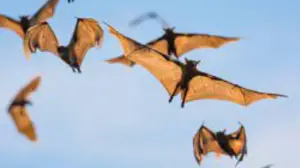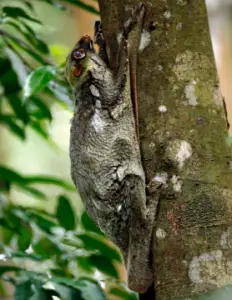Gliding mammals
While most mammals are earthbound, some have adapted the amazing ability to take to the air and glide. These mammals can propel themselves through the sky and even steer and maneuver along the way.
Gliding allows them to move quickly and efficiently between trees and across open spaces without touching the ground. Some major groups of gliding mammals include bats, flying squirrels, colugos, and marsupials like sugar gliders.
While not powered fliers, their gliding adaptations give them access to resources like food and mates while avoiding predators on the ground. The aerodynamic adjustments and lightweight skeletal structures that enable them to glide are remarkable products of evolution. In this blog post, we will talk and explore about Gliding mammals and their interesting facts.
Examples of Gliding Mammals
1. Bats

Bats are the only mammals capable of true powered flight. Their wings consist of a thin membrane of skin called the patagium that extends between the fingers, arm, and body. Different bat species have wingspans ranging from 6 inches to over 5 feet.
Bats are very agile fliers, and some can even hover and fly backward. They use echolocation to orient themselves and locate prey while in flight. There are over 1,300 species of bat that occupy habitats all over the world except the polar regions.
2. Flying Squirrels

With over 50 species, flying squirrels are the most diverse group of gliding mammals. Instead of bat-like wings, they have a furry membrane called a patagium that stretches between their front and hind legs. Using this and their flattened, rudder-like tail, they can steer and brake while gliding.
Flying squirrels are arboreal, living in the forests of North America, Europe, and Asia. They are mainly active at night and glide between trees to find food and escape predators.
3. Wrist-winged Gliders

Wrist-winged gliders, also known as dermopterans, are two species of colugos in southeast Asia. They have thin patagia like flying squirrels, but theirs stretch all the way from their wrists to their ankles.
This creates a parachute-like surface area enabling colugos to glide up to 200 feet between trees. They have specially adapted wrist bones that can rotate 180 degrees, providing greater maneuverability in the air.
4. Colugos

Colugos, also known as flying lemurs, are another group of gliding mammals from southeast Asia. There are only two species, the Sunda flying lemur and the Philippine flying lemur. They are not true lemurs, but got that name from their long tails and lemur-like faces.
Colugos have patagia stretching from their neck to tail that allow them to glide up to 230 feet. They are arboreal folivores that primarily eat leaves and shoots.
5. Scaly-tailed Flying Squirrels

The three species of scaly-tailed flying squirrels are found in forests stretching from Pakistan to Indonesia. They have patagia like other flying squirrels but are unique for the scaly, bushy tails they use as rudders while gliding.
Their large eyes provide excellent nocturnal vision as they glide between trees at night. Scaly-tailed flying squirrels are omnivores that eat fruit, leaves, insects, and even small birds.
6. Feathertail Gliders

Feathertail gliders are tiny marsupials, about the size of a mouse, found in the forests of eastern Australia. They are the smallest gliding mammals in the world, weighing only 0.14–0.71 ounces.
Skin membranes extend between their front and rear legs to form gliding membranes. With tails longer than their body, they steer by moving them side-to-side in flight. Active at night, these tiny marsupials eat sap, nectar, insects, and pollen.
7. Echolocation
Some gliding mammals like bats use echolocation to navigate in flight. They produce high-frequency calls and listen for the echoes that bounce back from objects around them. The time delay and qualities of the echo allow bats to perceive their surroundings in detail, even in complete darkness.
This helps them avoid obstacles and locate prey while on the wing at night. Other nocturnal gliding mammals have excellent low-light vision and specially adapted middle ears to help them orient in flight.
Conclusion
Gliding has evolved separately in several mammalian lineages, showing how useful this form of locomotion can be. Mammals like squirrels, lemurs, marsupials, and bats have all developed amazing anatomical adaptations that allow them to live and move effectively in the trees and sky.
Their exploits in the air remind us that mammals occupy diverse ecological niches, not just on land but in the air as well. The next time you see a shadow swoop between trees or spot a furry glider overhead, appreciate how its unique evolutionary journey has allowed it to take flight. Learn here more about Mammals and their interesting Facts.
FAQs:
What are gliding mammals?
Gliding mammals are those that can glide through the air without fully powered flight. They have adapted membranes of skin called patagia between their limbs that allow them to glide when they leap from trees. This allows them to cover distances horizontally between trees without having to descend to the forest floor.
How do gliding mammals glide?
Gliding mammals spread out their limbs, stretching the skin membranes. This creates an aerodynamic surface that allows them to glide once they leap from a high point. They use their tails and limbs to steer and stabilize themselves mid-air. The patagia create drag and lift forces that let them glide forward and even rise upward.
What are some examples of gliding mammals?
Some of the most well-known gliding mammals include flying squirrels, sugar gliders, colugos, scaly-tailed flying squirrels, and feather-tailed gliders. Bats are also capable of gliding flight in addition to powered flight.
How far can gliding mammals travel?
The glide distance depends on the size of the animal and environmental conditions like wind. Smaller mammals like the feather-tailed glider can glide up to 130 feet. Larger squirrels and colugos can glide over 200 feet. With assistance from wind gusts, some bats and large colugos can travel over 600 feet in a single glide.
Why do mammals glide?
Gliding allows arboreal mammals to move efficiently through the forest canopy. It gives them rapid access to resources like food and nest sites while avoiding predation. Gliding is energy efficient compared to climbing down and back up trees. It also provides a quick escape from predators.
How did gliding adaptions evolve in mammals?
Gliding most likely evolved as an extension of adaptation for climbing and leaping between trees. Mammals that could stretch skin between limbs to catch more air gained more lift and distance. Natural selection then favored anatomical changes like patagia and skeletal adjustments that improved aerodynamics and performance.
Do gliding mammals flap their limbs to fly?
No, gliding mammals do not flap their limbs to generate powered flight. Instead, they spread their gliding membranes and use their bodies much like a parachute, gliding passively once airborne. However, they can use their tails, limbs, and membranes to steer and brake.
Can any mammal evolve to glide?
Mammals that frequently climb and leap in trees have the most potential to evolve gliding adaptations. Arboreal habitats favor patagia and other adjustments that allow better aerial maneuvering. Still, gliding has only evolved in a few mammalian lineages, suggesting certain constraints on this adaptation.
Are gliding mammals related to flying squirrels?
The diversity of gliding mammals shows they do not share a close common ancestor. Groups like colugos, marsupial sugar gliders, and placental flying squirrels evolved gliding separately. However, the many species of flying squirrels are closely related and share common descent.


